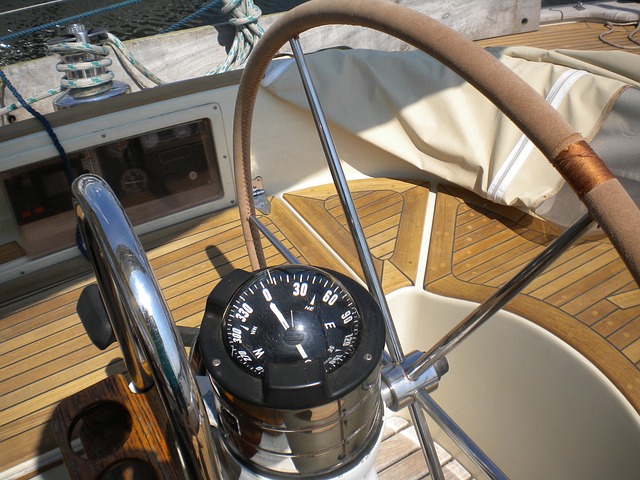Mastering Marine Battery Wiring: A Safe Guide for Optimal Boat Battery Systems
A comprehensive wiring diagram is essential for installing and maintaining a safe and efficient boat battery system. It guides the interconnection of all electrical components, from batteries to switches, fuses, and charging systems. Following this diagram ensures that electricity flows correctly, …….

A comprehensive wiring diagram is essential for installing and maintaining a safe and efficient boat battery system. It guides the interconnection of all electrical components, from batteries to switches, fuses, and charging systems. Following this diagram ensures that electricity flows correctly, protecting the system against short circuits and ensuring optimal performance. Regularly consulting the wiring diagram during troubleshooting helps pinpoint issues like poor connections or battery problems. Proper installation as per the wiring diagram also facilitates routine maintenance tasks such as inspecting terminals for corrosion, applying dielectric grease, and managing the state of charge to prolong battery life. Adherence to these practices ensures that your boat's electrical system and batteries remain reliable and functional for all your nautical adventures.
Navigating the waters of marine electronics requires a solid understanding of your vessel’s power distribution, with particular attention to boat battery setups. A well-designed wiring diagram is your compass and map in this endeavor, guiding you through the complex network of connections that power everything from navigation systems to onboard entertainment. This article demystifies the importance of proper wiring for boat batteries, detailing the anatomy of a boat battery system, the risks of getting it wrong, and providing a step-by-step approach to utilizing marine battery wiring diagrams. With insights into key components and maintenance tips, you’ll ensure your boat’s battery system operates at peak efficiency, keeping you afloat in safety and style.
- Understanding the Importance of Proper Wiring in Boat Battery Systems
- The Anatomy of a Boat Battery System: What You Need to Know
- Risks Associated with Incorrect Battery Wiring on Boats
- Step-by-Step Guide to Reading and Utilizing Marine Battery Wiring Diagrams
- Key Components in Your Boat's Battery Wiring Diagram
- How to Safely Connect and Install Boat Batteries Using a Diagram
- Troubleshooting Common Issues with Boat Battery Systems Using Wiring Diagrams
- Maintenance Tips for Long-Term Reliability of Your Boat's Battery Setup
Understanding the Importance of Proper Wiring in Boat Battery Systems

When configuring a boat’s electrical system, particularly its battery setup, understanding the intricacies of proper wiring is paramount for the safety and efficiency of the vessel. A well-designed wiring diagram for boat batteries serves as a roadmap to ensure each connection is made correctly, minimizing the risk of short circuits or overcharging that can lead to battery failure or even pose a fire hazard. The integrity of a boat’s electrical system hinges on the correct installation and interconnection of these power sources, which is where the significance of following a wiring diagram becomes clear. These diagrams meticulously outline the series and parallel configurations necessary for optimal performance, detailing how to connect batteries to achieve the desired voltage and amperage for the boat’s electrical needs. For instance, two 12-volt batteries wired in series will yield a 24-volt system, which is suitable for trolling motors and other 24-volt devices. Similarly, parallel connections allow for simultaneous charging from different sources, ensuring all batteries reach full capacity at the same rate. This not only extends the life of the batteries but also guarantees that the boat’s electrical systems operate reliably, even in the most demanding conditions on the water. In essence, adhering to a wiring diagram is essential for maintaining the functionality and longevity of your boat’s battery system, which is a critical aspect of the overall safety and performance of your vessel.
The Anatomy of a Boat Battery System: What You Need to Know

When exploring the intricacies of a boat battery system, understanding its components and their functions is paramount for effective maintenance and usage. At the heart of every boat’s electrical system lies the battery or set of batteries responsible for powering everything from navigation lights to onboard entertainment systems. Boat batteries are not your average lead-acid or AGM (Absorbent Glass Mat) types found in cars; they are specifically designed to endure the harsh marine environment, which includes fluctuating temperatures and frequent vibrations due to the boat’s movement.
Typically, a boat battery system consists of one or more deep-cycle batteries connected in series or parallel, depending on the power requirements. These batteries are the primary energy storage devices and are often larger than their automotive counterparts to provide sufficient capacity for prolonged use. The system also includes a charge controller or regulator that maintains the state of charge of the batteries by converting the alternator’s output voltage to a charge suitable for the battery. Additionally, safety features such as fuses and circuit breakers are integrated to protect the electrical system from overcharging or short circuits. A proper wiring diagram for a boat battery setup is essential to ensure all components are connected correctly and safely, optimizing the performance of your vessel’s power system. Following a detailed wiring diagram helps avoid misinterpretation of complex electrical schematics, which can lead to operational issues or even hazardous situations. By adhering to these guidelines, you can rest assured that your boat’s battery system is set up for peak efficiency and reliability.
Risks Associated with Incorrect Battery Wiring on Boats

Step-by-Step Guide to Reading and Utilizing Marine Battery Wiring Diagrams

When installing or maintaining a marine battery system, adhering to a wiring diagram is an indispensable step to ensure safety and functionality. A well-constructed wiring diagram for boat batteries serves as a visual guide, detailing each connection and component required for the battery setup. It outlines the specific path that electrical current will take from the battery to the various onboard systems such as navigation lights, depth finders, and bilge pumps, and back to the battery, providing a clear and systematic approach to the installation process.
To begin, acquire the correct wiring diagram for your particular boat battery model and setup. This ensures that the connections and components are accurately represented. Start by examining the diagram to understand the layout of the system, including the location of each battery, the path of the cables, and the points where connections will be made. Pay close attention to the color coding of wires, as it often correlates with the function of each circuit, aiding in both installation and troubleshooting later on. Next, gather all necessary tools and materials, including wire strippers, connectors, battery terminals, and the batteries themselves. Follow the diagram step by step, starting with connecting the batteries in series or parallel, as required, to achieve the desired voltage. Carefully wire each component according to its designated location and connection points on the diagram. Verifying each connection with the diagram at each juncture will help prevent errors that could lead to improper function or safety risks. Once all components are connected, conduct a thorough test to ensure that everything operates as intended. This methodical approach, guided by the wiring diagram, is crucial for the safe and effective use of your boat’s battery system.
Key Components in Your Boat's Battery Wiring Diagram

When setting up or maintaining your boat’s electrical system, understanding the intricacies of your boat battery wiring diagram is paramount for safe and efficient operation. A well-crafted wiring diagram for a boat’s battery system outlines the flow of electrical current from the power source to various components, ensuring that each element receives the appropriate voltage. Key components in this setup include the batteries themselves, which serve as the energy storage units; the battery switches, which allow for the control of power distribution; and the wiring, which connects these components while protecting against short circuits with fuses or circuit breakers. Additionally, the diagram will detail the placement of the battery monitor, an essential tool for tracking your boat’s battery health and usage, as well as the charging system, which is responsible for rejuvenating the batteries after they have been discharged. Properly following a wiring diagram ensures that each component, from the starter battery to the house bank, is correctly interconnected, optimizing your boat’s performance and reliability on the water. Understanding these components and their relationships within the system is not just about theoretical knowledge; it directly impacts the safety, longevity, and functionality of your marine batteries and the overall electrical infrastructure of your vessel.
How to Safely Connect and Install Boat Batteries Using a Diagram

When installing or connecting boat batteries, adherence to a wiring diagram is paramount for both safety and functionality. A wiring diagram provides a clear visual representation of how each component in the electrical system interconnects, ensuring that all connections are made correctly. To begin, carefully study the provided wiring diagram for your specific boat battery setup. This diagram will detail the necessary steps to connect the batteries in series or parallel, depending on your power requirements and the type of batteries you have. It’s essential to understand the polarity of each battery terminal and the flow of electrical current to avoid short circuits, which can lead to overheating and potential hazards.
Before making any connections, ensure that all batteries are fully charged to prevent any adverse reactions from different charge levels. Use the diagram as a guide to connect the positive (red) and negative (black or white) terminals accordingly. Pay close attention to the placement of each battery within the compartment, ensuring they are securely mounted to avoid movement that could cause damage or short-circuiting. The wiring diagram will also indicate the correct gauge of wire to use for optimal performance and to prevent voltage drop. After making all connections, perform a continuity check with a multimeter to verify there are no breaks in the circuit and that all connections are sound. Finally, seal all battery terminals with dielectric grease to protect against corrosion, which can impair connection integrity over time. By meticulously following a wiring diagram during installation, you can ensure a reliable and safe boat battery system that will support your maritime adventures effectively.
Troubleshooting Common Issues with Boat Battery Systems Using Wiring Diagrams

When navigating common issues with boat battery systems, a wiring diagram serves as an invaluable tool for troubleshooting and maintenance. These diagrams provide a clear visual representation of the electrical layout, detailing where each component is connected and how they interact within the system. For instance, if a boat’s battery system fails to hold a charge, consult the wiring diagram to trace the path from the charging source through the batteries and to the rest of the vessel’s electrical circuitry. This can help pinpoint whether the issue lies with the alternator, the battery itself, or potential wiring faults causing a poor connection or a short circuit.
Similarly, if the boat’s lights flicker or the starter motor is sluggish, a wiring diagram can guide you through checking for loose or corroded connections, which are frequent culprits in such scenarios. The diagram will show the color-coding and layout of each wire, allowing you to swiftly verify that all terminals and connectors are secure and free from oxidation. This step-by-step guidance not only aids in resolving immediate problems but also helps prevent future issues by ensuring optimal performance and longevity of the boat battery system. Using wiring diagrams for troubleshooting common issues with boat battery systems is a proactive approach that ensures safety, reliability, and efficiency on the water.
Maintenance Tips for Long-Term Reliability of Your Boat's Battery Setup

When it comes to maintaining your boat’s battery setup for long-term reliability, understanding and following a wiring diagram is crucial. These diagrams provide a visual guide for the correct installation and connection of your batteries and associated components, ensuring optimal performance and safety. Regularly inspect the battery terminals and cables for corrosion or wear, as these can degrade over time and lead to poor connections or even short circuits. Use a wire brush to clean any corrosion from the terminals and apply a dielectric grease to protect them from future corrosion. Ensure that all connections are tight but not overly torqued, as this can damage the terminals.
For long-term reliability, it’s important to maintain the state of charge of your boat batteries. This involves regular charging and discharging within the recommended voltage ranges to prevent sulfation and extend the lifespan of the cells. Equally important is storing your boat batteries properly when not in use. If you’re going to store them for an extended period, ensure they are fully charged and kept at a moderate temperature. Use a battery charger or maintainer designed for marine batteries to keep the batteries at a partial state of charge, as this minimizes the formation of sulfate crystals on the plates, which can impair battery capacity. Additionally, regularly check the electrolyte levels and add distilled water as needed to maintain the proper fluid quantity without overfilling. By adhering to these maintenance tips and following the specifications outlined in your wiring diagram, you can ensure that your boat’s battery setup will serve you reliably for many years on the water.
When navigating the complexities of a boat’s battery system, adherence to a precise wiring diagram is indispensable. As detailed in the article, understanding the anatomy of your boat’s battery setup and the risks of incorrect wiring cannot be overstated. Following a structured guide to reading marine battery wiring diagrams ensures not only the safety of your vessel but also its operational efficiency. By familiarizing yourself with the key components and employing the step-by-step instructions provided, you can confidently install and maintain your boat batteries. Addressing common issues through troubleshooting with the aid of these diagrams will further enhance the reliability of your boat’s power system. In essence, a wiring diagram serves as a vital tool for any boater, guaranteeing a well-functioning battery setup that supports both immediate and long-term needs on the water.







